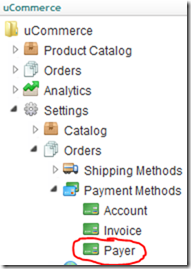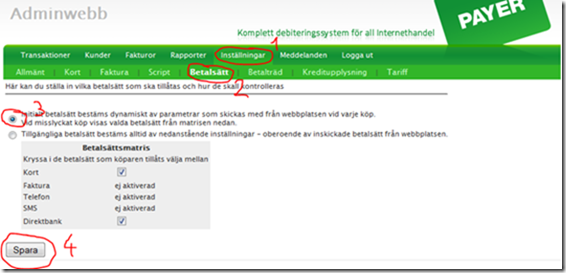Setup Ucommerce to Include Payer as a Payment Method
Ucommerce comes with built-in support for Payer payments. This guide will walk you through getting Ucommerce to work with Payer for payment processing.
Authorization is available for all plans with Payer. Payer don’t support remote acquire (capture), refund, or cancel of payments. When an authorization is made the payment is automatically captured and cannot be overridden using configuration. To refund a payment, you must use the Adminwebb.
Settings in Ucommerce
Add a new payment method, under “Ucommerce –> Settings –> Orders –> Payment Methods”. You can call it whatever you like, here I have used “Payer”.

Click the newly created node and select “Payer” in the Service drop down list. Fill out the rest of the required information, like where it’s available from under the “Access” tab, pricing and the language tabs. When you are done click “Save”.

That’s everything in the Ucommerce interface.
Settings in Payer Administration Panel
Changes needed in the Adminwebb, so it will work with Ucommerce.
Payment Methods
-
Click “Inställningar”.
-
Click ”Betalsätt”.
-
Make sure the top radio button is selected. If it’s not, select it.
-
Click the “Spare” button.

Debug options
-
Click “Inställningar”.
-
Click ”Allmänt”.
-
Make sure all three checkbox’s are unchecked, if not do it.
-
Click “Spara”.

Editing the Payer.config File
Now we need to edit the Payer.config file.
You will find the Payer.config file in the following location, where “rootdir” is the directory on the computer where you installed Umbraco: “rootdir\umbraco\UCommerce\Configuration\Payer.config”. Usually “rootdir” is c:\inetpub.

Some of the below information are found in the Adminwebb, so start by logging in you aren’t already.
Finding agentId, key1 and key2
In the compressed starting package, "Startpaket", you can find the Agent ID and the keys beneath the catalog "Resources", in the files called "PayReadConf.*".
Finding debug
If set to “True” you will be prompted to click a button before posting the information to “ePay” otherwise it will do an autosubmit using Javascript. When running in production, you will want this set to “False”.
Finding testMode
This setting must match the configuration in the Adminwebb. If you followed the steps in “Debug options” above, you should set this to “False”, indicating that we are running in production.
Finding callback
Leave this at “(auto)” if in doubt.
Finding acceptUrl
Url the user is returned to after successfully authorizing her credit card.
Finding cancelUrl
Url the user is returned to if she cancels a purchase.
Executing a Pipeline on Callback
Running a pipeline once payment is authorized can be helpful if you need to complete the order once the customer returns to your site.
To run a “pipeline” once the callback if received and processed, you need to modify the database. If you used the name “Payer” for the payment method name, you can run this SQL query in the SQL Server Management Studio.
UPDATE Ucommerce_PaymentMethod SET Pipeline = 'Checkout' WHERE Name = 'Payer'
or just edit it manually in SQL Server Management Studio.

Now the default piplline that comes with Ucommerce will be run after each successful callback. This sets the Basket to an Order, gives it an OrderNumber, and other things.
